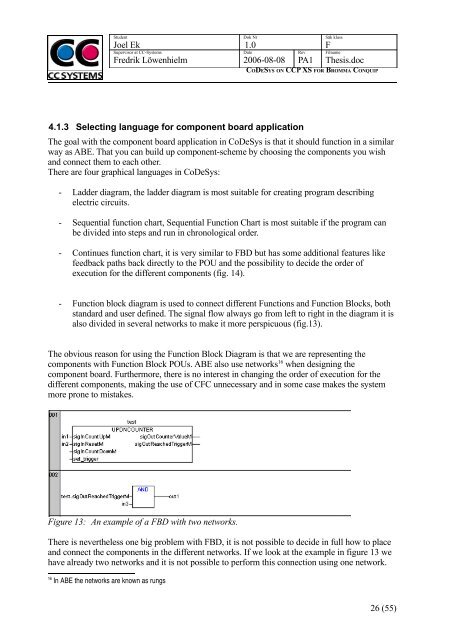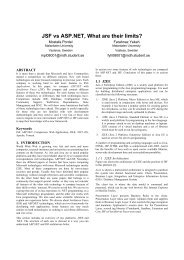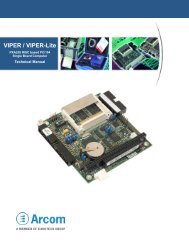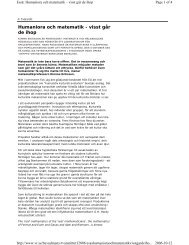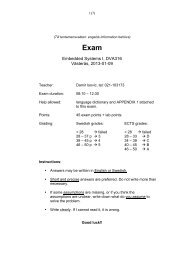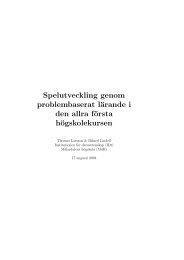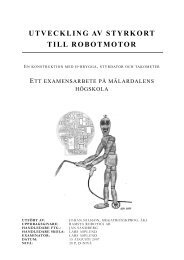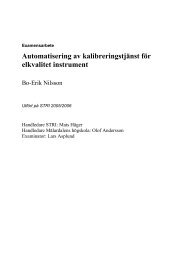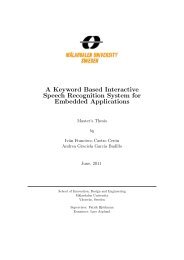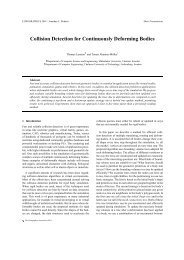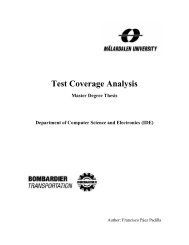CoDeSys on CCP XS for Bromma Conquip - Research
CoDeSys on CCP XS for Bromma Conquip - Research
CoDeSys on CCP XS for Bromma Conquip - Research
- No tags were found...
You also want an ePaper? Increase the reach of your titles
YUMPU automatically turns print PDFs into web optimized ePapers that Google loves.
Student<br />
Joel Ek<br />
Supervisor at CC-Systems<br />
Fredrik Löwenhielm<br />
Dok Nr<br />
1.0<br />
Date<br />
2006-08-08<br />
Rev<br />
PA1<br />
Säk klass<br />
F<br />
Filname<br />
Thesis.doc<br />
CODESYS ON <strong>CCP</strong> <strong>XS</strong> FOR BROMMA CONQUIP<br />
4.1.3 Selecting language <strong>for</strong> comp<strong>on</strong>ent board applicati<strong>on</strong><br />
The goal with the comp<strong>on</strong>ent board applicati<strong>on</strong> in <str<strong>on</strong>g>CoDeSys</str<strong>on</strong>g> is that it should functi<strong>on</strong> in a similar<br />
way as ABE. That you can build up comp<strong>on</strong>ent-scheme by choosing the comp<strong>on</strong>ents you wish<br />
and c<strong>on</strong>nect them to each other.<br />
There are four graphical languages in <str<strong>on</strong>g>CoDeSys</str<strong>on</strong>g>:<br />
- Ladder diagram, the ladder diagram is most suitable <strong>for</strong> creating program describing<br />
electric circuits.<br />
- Sequential functi<strong>on</strong> chart, Sequential Functi<strong>on</strong> Chart is most suitable if the program can<br />
be divided into steps and run in chr<strong>on</strong>ological order.<br />
- C<strong>on</strong>tinues functi<strong>on</strong> chart, it is very similar to FBD but has some additi<strong>on</strong>al features like<br />
feedback paths back directly to the POU and the possibility to decide the order of<br />
executi<strong>on</strong> <strong>for</strong> the different comp<strong>on</strong>ents (fig. 14).<br />
- Functi<strong>on</strong> block diagram is used to c<strong>on</strong>nect different Functi<strong>on</strong>s and Functi<strong>on</strong> Blocks, both<br />
standard and user defined. The signal flow always go from left to right in the diagram it is<br />
also divided in several networks to make it more perspicuous (fig.13).<br />
The obvious reas<strong>on</strong> <strong>for</strong> using the Functi<strong>on</strong> Block Diagram is that we are representing the<br />
comp<strong>on</strong>ents with Functi<strong>on</strong> Block POUs. ABE also use networks 16 when designing the<br />
comp<strong>on</strong>ent board. Furthermore, there is no interest in changing the order of executi<strong>on</strong> <strong>for</strong> the<br />
different comp<strong>on</strong>ents, making the use of CFC unnecessary and in some case makes the system<br />
more pr<strong>on</strong>e to mistakes.<br />
Figure 13: An example of a FBD with two networks.<br />
There is nevertheless <strong>on</strong>e big problem with FBD, it is not possible to decide in full how to place<br />
and c<strong>on</strong>nect the comp<strong>on</strong>ents in the different networks. If we look at the example in figure 13 we<br />
have already two networks and it is not possible to per<strong>for</strong>m this c<strong>on</strong>necti<strong>on</strong> using <strong>on</strong>e network.<br />
16<br />
In ABE the networks are known as rungs<br />
26 (55)


